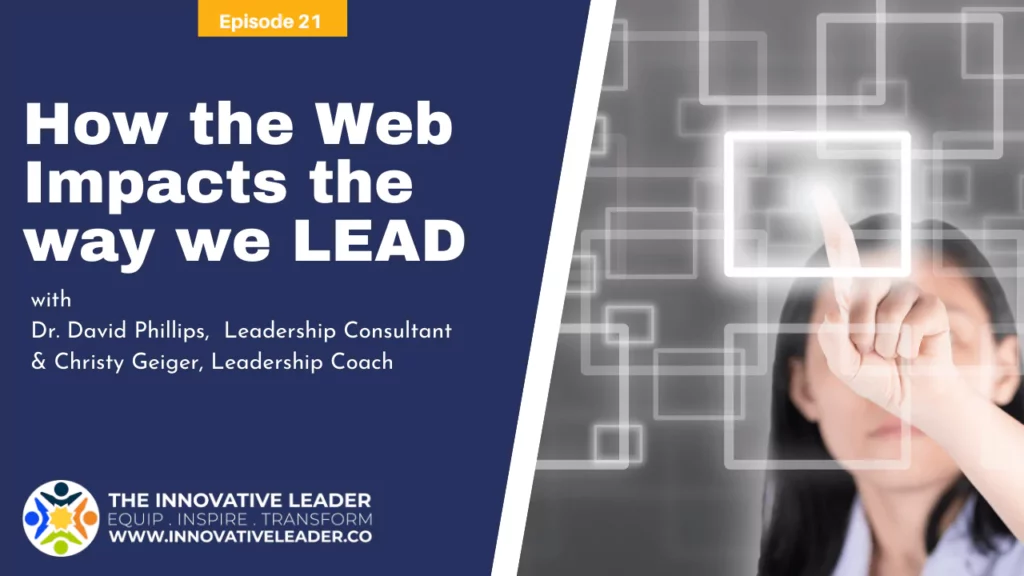Welcome Leaders! Thank you for joining the Innovative Leader Podcast. I am Christy Geiger, Executive Leadership Coach, here with David Phillip, Leadership Consultant. We are passionate about leadership and transforming the way we lead. Each week we share thoughts for leaders to equip, inspire, and transform how we lead in life and work. Today we are looking at to topic of How the Web Impacts the Way We Lead. Leaders – this is a platform for you to share too! If you have questions, ideas, or comments please share in the comments and follow on YouTube or any channel you get your podcasts – we want to grow a community of leaders supporting one another.
Today David and I jump into a topic to provide some context of where the term Leadership 4.0 comes from. I am not familiar with anyone else really using that term, but we are using it to match the current status and changes that are happening and influencing leadership today. We are currently in what is known as Industry 4.0 and Web 4.0. These terms speak to the current evolution we are in regarding the Industrial Era and the Web. Our leadership is greatly affected by what is happening around us. If you think back to when factories and manufacturers were growing, the demand for “managers” and “management training” grew. Now, we are in a very different season. Listen in to get some context on what has brought us to today and how that starts to affect HOW WE LEAD.
First, What were the stages of the web?
To understand the web, it is helpful to get a framework of where we have been in the world in the last 200 years. It helps to connect the dots to see the patterns in innovation and developments. Today we are in Industry 4.0 and Web 4.0
-
- When we look at the Industrial Revolution – there have been Four “Eras”
- First Industrial Revolution said to be from 1760 to 1840 (marked by key economic and social changes with significant growth in industries such as the shift from hand production to machines, chemical manufacturing, iron production, coal, steam and water power, etc.)
- Second Industrial Revolution said to be from 1870 to 1914 (known for the expansion of electricity, petroleum, and steel and advancements for the steel mills, the telephone, electric light, and the typewriter) (https://ushistoryscene.com/article/second-industrial-revolution/)
- Third Industrial Revolution said to be from the 1950s to ~2015 (“The third revolution brought forth the rise of electronics, telecommunications and of course computers. Through the new technologies, the third industrial revolution opened the doors to space expeditions, research, and biotechnology.” This lead to the innovation of robots and high-level automation which contributes to the increasing speed of things felt today. https://ied.eu/project-updates/the-4-industrial-revolutions/ )
- We are just entering the Fourth Industrial Revolution, also called Industry 4.0 (or I4.0 or I4), a term which started developing in Germany in 2011 and gaining in understanding into 2017 – present. (there is some debate if we are in-fact in a new era and stage of the revolution, however, we agree we are at the start of this new era given the demands for changing and upgrading how we work and think. It can be difficult at times to see this when we are in the middle of it … however worth separating from the era we were just in. It is marked by the increasing changes in SMART technology, Internet of Things (IoT), advancements in communication, cloud, 3D printing, AI, etc.) https://en.wikipedia.org/wiki/Fourth_Industrial_Revolution
- The Web evolved in 4 stages during the Third Industrial Revolution. When thinking about how many years each Industrial Revolution covers, the iterations of the web have developed and evolved extremely quickly. (*there is debate on the exact generational dates, use as a rough reference)
- When we look at the Industrial Revolution – there have been Four “Eras”
-
-
- web 1.0, 1960-1980 – launched privately within the military in a project called Darpa military
- web 1.0, 1980-1995 – came to PUBLIC use
- generations of adults were the Silent Generation (1925-1945), the Baby Boomers (1946-1965) and Gen X (1966-1976)
- Millennials (aka Gen Y) 1977-1994 were BORN and CHILDREN (and this is the new “norm”)
- milestones: the personal computer, dial-up and modems, 24×7 accessibility to information, AOL and email, Netscape, HTML, AltaVista, etc.
- attributes: Static information. One authority by those who had the means to post. More of a ONE WAY communication.
- web 2.0, 1996-2005
- the generation that grew up during this time is Millennials (aka Gen Y) 1977-1994 / Gen Z 1995-2012 (this is their “norm”)
- milestones: The Internet, Amazon, Networks, Cell phones.
- attributes: TWO WAY communication. Ability to get and respond to information. Instant communication (email, messaging, the birth of social media, etc.). Global.
- web 3.0, 2006-2017
- the generation born or coming into elementary Gen Z 1995-2012 / Gen Alpha 2010+ (this is their “norm”)
- milestones: Interactive tools, Social Media, iPhone, streaming, video, cloud, etc.
- attributes: THREE WAY communication, Mobility, Flexibility, Remote, and dynamic.
- web 4.0/industry 4.0 era – in it for about 3 years… internet of things (new) 2017 (gen Alpha 2010+)
- the generation born or coming into elementary Gen Alpha 2010+ (this is their “norm”)
- developments anticipated: augmented reality, Big data, digital alter ego, new interfaces, like intelligent machines (AI), holograms
- attributes: interconnectivity, AI intelligent/responsive, intelligent machines, less human control, more invisible
- learn more: https://www.criticalcase.com/blog/what-is-web-4-0.html or https://pandorafms.com/blog/web-4-0/
-
Second, How have those web developments changed the way we work?
-
- more educated and resourceful, more informed, and trust authority
- world vs city is my canvas – expanded awareness (good, bad, and needy)
- speed
Third, how does it change the way we lead?
-
- It changes the purpose of leadership
-
- share the direction and clear vision
- create connections and build relationships
- changes how we hire, train, communicate and work together
- create a positive experience for all people (team and customer)
-
- How?
-
- dynamically drive a big picture purpose and goal
- have a plan but able to dynamical adjust as needed
- be aware of complexity and dynamics (constant ripples and changes)
- ability to filter, make decisions and dynamically adapt
- make the complex simple & communicate to the team providing certainty and empowering their work
- coach and influence vs authority
-
- It changes the purpose of leadership
Reflect – How do you feel the WEB innovations have impacted how you work and lead?
-
-
- where are you in the industrial revolution and WEB stages?
- where do you function best?
- what do you notice?
- what in your leadership needs to adapt but you might be resisting?
- what about your leadership feels 4.0?
- what would make it more 4.0?
-
Thank you for listening in to the Innovative Leader Podcast with David Phillips, Leadership Consultant, and Christy Geiger, Leadership Coach. We are passionate about leadership and transforming the way we lead. Each week we share thoughts for leaders to equip, inspire, and transform how we lead in life and work. If you have questions, ideas, or comments please share in the comments, make sure to subscribe, or follow on YouTube or any channel where you get your podcasts and share with other leaders. We want to grow a community of leaders supporting one another! www.innovativeleader.co






